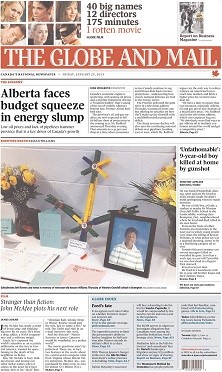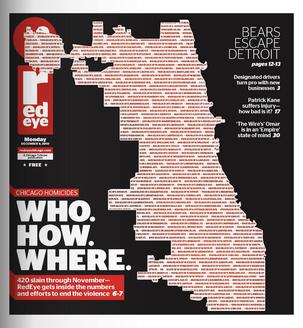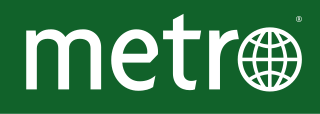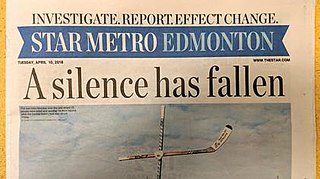
A tabloid is a newspaper with a compact page size smaller than broadsheet. There is no standard size for this newspaper format.

Print circulation is the average number of copies of a publication. The number of copies of a non-periodical publication are usually called print run. Circulation is not always the same as copies sold, often called paid circulation, since some issues are distributed without cost to the reader. Readership figures are usually higher than circulation figures because of the assumption that a typical copy is read by more than one person.

The Globe and Mail is a Canadian newspaper printed in five cities in western and central Canada. With a weekly readership of approximately 2 million in 2015, it is Canada's most widely read newspaper on weekdays and Saturdays, although it falls slightly behind the Toronto Star in overall weekly circulation because the Star publishes a Sunday edition, whereas the Globe does not. The Globe and Mail is regarded by some as Canada's "newspaper of record".

RedEye is a publication put out by the Chicago Tribune geared toward 18 to 34-year-olds. It was published every weekday since its inception until February 3, 2017. Publication was reduced to weekly starting February 9, 2017. Daily circulation was 250,000 as of December 2, 2009.

Metro International is a Swedish global media company based in Luxembourg that publishes the Metro newspapers. Metro International's advertising sales have grown at a compound annual growth rate of 41 percent since launch of the first newspaper edition in 1995. It is a freesheet, meaning that distribution is free, with revenues thus generated entirely through advertising. This newspaper is primarily intended for commuters who move daily in and out of big cities' business areas, mainly during rush hours.

Metro is the United Kingdom's highest-circulation freesheet newspaper. It is published in tabloid format by DMG Media. The newspaper is distributed from Monday to Friday mornings on trains and buses, and at railway/Underground stations, airports and hospitals across selected urban areas of England, Wales and Scotland. Copies are also handed out to pedestrians.

The Daily News was a tabloid newspaper in Halifax, Nova Scotia, that was published from 1974 until ceasing operations in February 2008.
An alternative newspaper is a type of newspaper that eschews comprehensive coverage of general news in favor of stylized reporting, opinionated reviews and columns, investigations into edgy topics and magazine-style feature stories highlighting local people and culture. Its news coverage is more locally focused, and their target audiences are younger than those of daily newspapers. Typically, alternative newspapers are published in tabloid format and printed on newsprint. Other names for such publications include alternative weekly, alternative newsweekly, and alt weekly, as the majority circulate on a weekly schedule.

Free newspapers are distributed free of charge, often in central places in cities and towns, on public transport, with other newspapers, or separately door-to-door. The revenues of such newspapers are based on advertising. They are published at different levels of frequencies, such as daily, weekly or monthly.

24 Hours was a group of English-language and French-language free daily newspapers published in Canada. It was published in French in Montreal and Gatineau and in English in Calgary, Edmonton, Ottawa, Toronto, and Vancouver. The Gatineau edition was discontinued in 2008 and the Calgary, Edmonton, and Ottawa editions ceased publication in 2013. The Toronto and Vancouver editions were sold to Postmedia Network as part of Quebecor's divestment of English-language news, and they were later acquired by Torstar in an asset swap on November 27, 2017 and immediately shut down in favour of the Torstar-owned Metro papers in those cities.
Headline Daily was launched on 12 July 2005, by Sing Tao Newspaper Group Limited and became the second free Chinese-language newspaper published officially in Hong Kong. The paper is only distributed on weekdays and is aimed at the working class. The estimated average daily circulation of the paper is around 900,000-1,000,000. The paper provides local and international news as well as articles on business news, entertainment, lifestyle and sports.

Métro is a French-language free daily newspaper published in Montreal, Quebec, Canada. The paper is wholly owned by local businessman Michael Raffoul who owns print media distribution company Transmet. Journal Metro is part of the Metro Media group which owns several local newspapers in Montreal. Journal Métro Montréal was formerly part of the international group of newspapers Metro International.

City A.M. is a free business-focused newspaper distributed in and around London, England, with an accompanying website. Its certified distribution was 85,738 copies a day in February 2020, according to statistics compiled by the ABC, and has a digital audience of just over 2 million unique visitors a month.

The Daily Press Inc. is a daily morning newspaper published in Newport News, Virginia, which covers the lower and middle Peninsula of Tidewater Virginia. It was established in 1896 and bought by Tribune Company in 1986. Current owner Tribune Publishing spun off from the company in 2014. In 2016, The Daily Press has a daily average readership of approximately 101,100. It had a Sunday average readership of approximately 169,200. Using a frequently used industry-standard readership of 2.2 readers per copy, the October 2022 readership is estimated to be 38,000. It is the sister newspaper to Norfolk's The Virginian-Pilot, which was its southern market rival until Tribune's purchase of that paper in 2018; the papers have both been based out of the Daily Press building since May 2020.

WSJ. or WSJ. Magazine, which was originally intended to be a monthly magazine named Pursuits, is a luxury glossy news and lifestyle monthly magazine by the publishers of The Wall Street Journal. It features luxury consumer products advertisements and is distributed to subscribers in large United States markets as well as throughout Europe and Asia. Its coverage spans art, fashion, entertainment, design, food, architecture, travel and more. Kristina O'Neill is Editor in Chief. Launched as a quarterly in 2008, the magazine grew to 12 issues a year for 2014.

A newspaper is a periodical publication containing written information about current events and is often typed in black ink with a white or gray background.

tonight was a free afternoon newspaper in Toronto, Ontario, Canada, founded in 2009 and acquired by Annex Business Media in 2013. Targeted at evening public transit commuters on GO Transit and TTC, its main distribution channels were through the use of newsies, newspaper boxes and PATH billboards throughout Toronto’s downtown core, and through newspaper boxes across the TTC. The publication name was originally stylized with periods as t.o.night - a tongue-in-cheek reference to Toronto. The newspaper was unique in Canada, with its magazine size and format, making for easy transit reading.
The term mass media refers to any means or technology used to communicate a message to large groups of people. Popular forms of mass media include television, the Internet, and newspapers. Mass media are specifically intended to reach larger audiences. The term is often divided into two broad categories: that of electronic mass media and that of print mass media. Electronic mass media require their audiences to interact with electronics in order to receive the message. They attempt to recreate or represent a message through moving pictures and/or sound. Four common examples of electronic media used in Canadian society are television, radio, films, and the Internet. Print mass media, on the other hand, refers to any media that is distributed to audiences in a printed form, on paper. Examples of this include newspapers, printed books, and magazines. The mass media model in Canada is different from the mass media model of the United States as well as the rest of the world. According to John A. Irving, mass media functions differently in Canadian society because of a lack of collective identity; this is in reference to Canada's languages as well as its proximity to the United States. Irving states that such cultural dualism means that only some of the population responds to the mass media in English, while the other portion remain uninfluenced by English-based media. In terms of the proximity to the United States, he explains that "most of the difficulties that threaten the mass media in Canada are the direct outcome of American economic and cultural imperialism." Because of the United States' overwhelming influence on Canadian mass media, Canada has not been able to form its own identity in the media. These two factors have slowed down the process of the creation of a Canadian community. Mass media help in forming a community through communication. When a large group of people is in communication with one another through media, an identifiable culture is formed. Individuals in dialectic experience a sense of membership and collective identity.
Online journalism in India is a growing field shared between traditional media and the growing blogging community. Large media companies, traditionally print and television focused, continue to dominate the journalism environment now online but a growing group of dedicated bloggers are providing an independent voice.

StarMetro was a chain of Canadian free daily newspapers published in Calgary, Edmonton, Halifax, Toronto, and Vancouver. The chain was a joint venture between the Canadian publishing conglomerate Torstar and Swedish global media company Metro International. The chain was originally branded as Metro prior to rebranding on April 10, 2018. StarMetro was not affiliated with the French-language Métro newspaper published by TC Transcontinental in Montreal.















